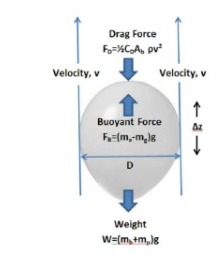Ice Breakers
.jpg)
Stratostar is an organization which aids to school and colleges for launching a high altitude balloon(IT DOES NOT TEND TO HOBBYISTS)
The following environmental factors affect the flight of the High Altitude Baloons:
1. Temperature and Pressure
2. Wind Speed and Direction of the Wind
3. Launch Location
The materials can be purchased from Amazon or Stratostar
Challenges that can be solved using physics
One of the major challenge faced by High Altitude Balloons is Buoyant force. The main reason why High Altitude Balloons are affected by buoyant force is because of its volume. As the volume of the High Altitude Balloon increases the buoyant force increases. Drag and Air Pressure are highly negligable
Balloon Gross Lift
The Balloon Gross Lift is the lift generated by the volume of Gas. Hydrogen has a density of about 0.09 kg/cu m and air about 1.2 kg/cu m at normal atmospheric pressure - generating a lift of a bit over I. !kg/cum. Helium has a density of about O.l 7Kg/cu m - generating a lift of a bit over l.OKg/cu m. Subtract the Balloon Weight plus the Payload weight form the Gross Lift to give the free lifi. The Recommended Free Lift gives a Rate of Ascent of 320m/min (a bit over lOOOft per minute). Heavier payloads can be carried than the values above - this will either reduce ascent rate, burst altitude (if the balloon is further infl ated to compensate) or both.
Starting with the basic equations of motion in a viscous fluid a relationship is obtained relating the ascent velocity to the balloon size and gas parameters, to the atmospheric parameters, and to the fluid flow viscosity parameters (coefficient of drag and Reynolds number). In addition, the differential thermal heat transfer is important for understanding lift particularly around the tropopause region where the ascending balloon gas is expanding (and cooling) while the external stratospheric temperature is increasing. The detailed equations of motion are fundamentally based on the more complex thermodynamic and fluid dynamic equations with aerodynamic forces and balloon shape changes from a sphere.

The upward buoyant force or Gross Lift is F = (ma - mg)*g where m. is the balloon fill equivalent atmospheric mass that is displaced by the balloon gas mass, mg, and g=9.8 m/s2 is the acceleration of gravity. Hydrogen gas at STP has a density of 0.09 kg/cu m and air a density of about 1.2 kg/cu m which generates a lift of about I. !kg/cum. The balloon gross mass, ma, includes the mass of the rubber balloon, plus the mass of the payload,so that ma=mb + mp.
Drag Force
When the Balloon system is first launched it quickly accelerates to a constant upward speed based on force balance between the Free Lift force and the drag force, FL =F D